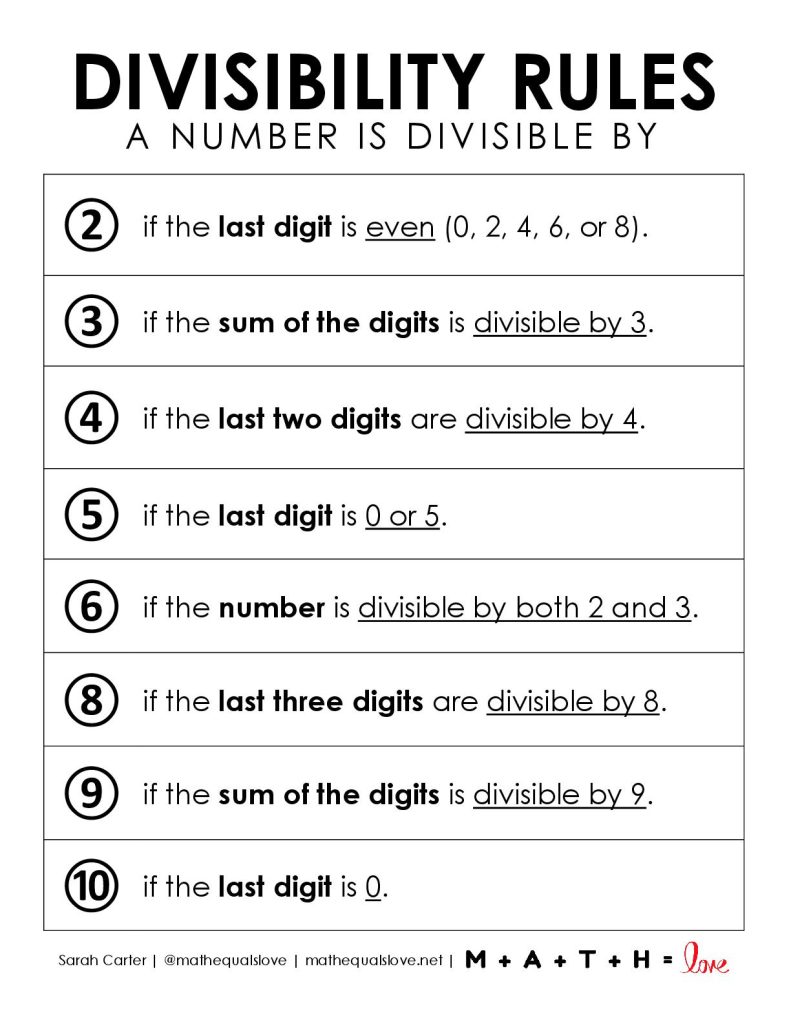
Help your students remember their divisibility rules with this free printable divisibility rules chart. It is also available to download as a poster for your classroom.

This divisibility rules chart would make the perfect reference for students playing my divisibility rules game, Is It Divisible?

It would also be a great reference for my divisibility rules puzzle.

Divisibility rules are easy to memorize tests that students can use to determine if any whole number is divisible by a given number. Often, this is referred to as performing a “divisibility test.”
Depending on what number you are looking to check for divisibility by, you might have to look at just the last digit of the number, you might have to consider the sum of the digits of the number, or you might have to do a combination of these.
A number is considered to be divisible by another number if there is no remainder when the two numbers are divided.
For example, 100 is said to be divisible by 10 because there is no remainder when 100 is divided by 10. 100 is not divisible by 3 because 3 goes into one hundred 33 times with a remainder of 1.
Technically, you could always use division to check if a number is divisible by another number. But often these divisibility rules provide a fast and easy way to tell if the original number divides evenly by a particular number without having to perform long division.
With small numbers, you can often tell if a number is divisible by a given number by simple inspecting the number. But as the provided numbers reach three or more digits, divisibility rules can come in very handy.
2: A number is divisible by 2 if the last digit is even (0, 2, 4, 6, or 8).
For example, 48 is divisible by 2 because the last digit of 48 (8) is even.
3: A number is divisible by 3 if the sum of the digits is divisible by 3.
For example, 96 is divisible by 3 because 15 (9 + 6) is divisible by 3.
4: A number is divisible by 4 if the last two digits are divisible by 4.
For example, 124 is divisible by 4 because 24 (the last two digits) is divisible by 4.
5: A number is divisible by 5 if the last digit is 0 or 5.
For example, 1000 is divisible by 5 because the last digit is 0.
6: A number is divisible by 6 if the number is divisible by both 2 and 3.
For example, 72 is divisible by 6 because it is divisible by both 2 and 3. We know 72 is divisible by 2 because its last digit is an even number. We know 72 is divisible by 3 because 9 (7 + 2) is divisible by 3.
8: A number is divisible by 8 if the last three digits are divisible by 8.
For example, 160 is divisible by 8 because the last three digits (160) are divisible by 8 (8*20 = 160).
9: A number is divisible by 9 if the sum of the digits is divisible by 9.
For example, 333 is divisible by nine because 9 (3 + 3 + 3) is divisible by 9.
10: A number is divisible by 10 if the last digit is 0.
For example, 90 is divisible by 10 because the last digit is 0.
I created this printable divisibility rules chart that can be placed in a student’s notebook to serve as a reference tool throughout the school year. Divisibility rules are first taught in elementary school, but their application extends through middle school and high school. It is never too late to provide students with a divisibility rules chart as a reference tool.

This printable divisibility rules chart is available to download as a PDF and as an editable Publisher file. In order to edit the Publisher file, you will need to make sure you have Microsoft Publisher installed on your computer.
Would you prefer to display these divisibility rules as a poster in your classroom? I resized the chart so it can be printed on 11 x 17 inch cardstock and be hung up as a wall chart or mini anchor chart.

 Divisibility Rules Activities" width="728" height="728" />
Divisibility Rules Activities" width="728" height="728" />




Sarah Carter teaches high school math in her hometown of Coweta, Oklahoma. She currently teaches AP Precalculus, AP Calculus AB, and Statistics. She is passionate about sharing creative and hands-on teaching ideas with math teachers around the world through her blog, Math = Love.